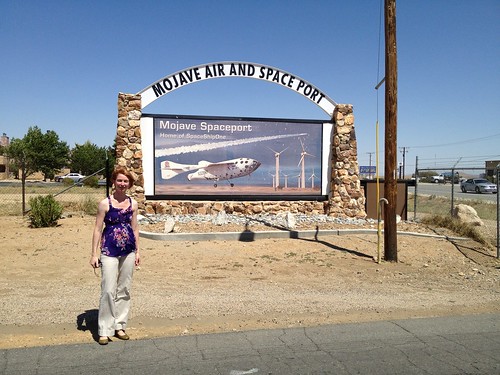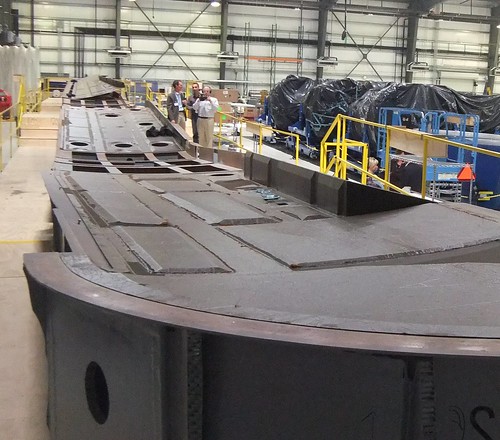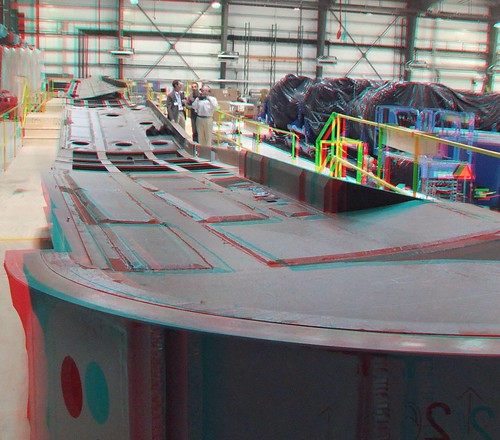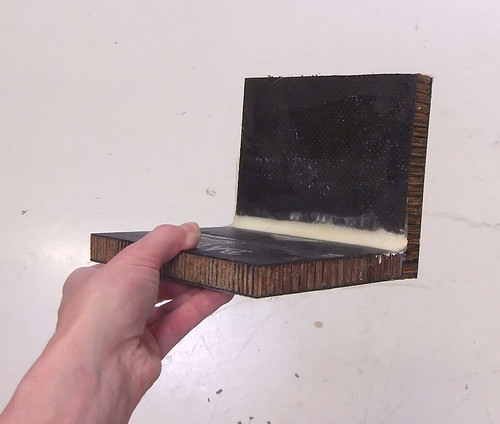Emily Lakdawalla • May 29, 2012
In which I visit Mojave Spaceport and meet WhiteKnightTwo and SpaceShipTwo
It was just a coincidence, but a cool one, that I got a chance to visit the Mojave Spaceport so soon after the dramatic "New Space" success of the launch and Space Station docking of SpaceX's Falcon 9 and Dragon. My host was Will Pomerantz, VP of Special Operations for Virgin Galactic. (The title, he says, "means anything I want it to.") Bill Nye, Mat Kaplan, and I visited The Spaceship Company and Scaled Composites, where they are building the next SpaceShipTwo and WhiteKnightTwo craft. We had a chance to walk up close to the prototype SpaceShipTwo and its mothership WhiteKnightTwo and actually touch them. I got to climb a few rungs up a stepladder and put my head inside and see the cockpit of WhiteKnightTwo. I wasn't allowed to take pictures on that part of the tour, sadly, but I'll do my best to describe it.
First, a little background. SpaceShipOne is the craft that won the X-prize for the first privately-built craft to go to space (defined as 100 kilometers altitude) twice in a week. SpaceShipTwo is its much larger successor. SpaceShipTwo will get to space the same way SpaceShipOne did. It's carried to high altitude by a twin-fuselage mother ship, then dropped, after which rocket engines take over to carry it above the atmosphere. It will get three or four weightless minutes with black space above before plummeting Earthward, its fall stabilized by twin tails that tip upward (an operation they call "feathering"). It glides to a landing, the mothership chasing behind it.

The mothership, WhiteKnightTwo, has flown more than 80 times and is just about cleared for routine flight. SpaceShipTwo has a bit farther to go, having gone aloft a bit more than 30 times; of those, it's been dropped from WhiteKnightTwo 16 times. All of those flights have been subsonic. The current estimated timeline is about two years until customers can pay to go to space.
Will took us first to a large hangar, one of the buildings in which the construction happens. No aircraft are currently under construction there now, but it was neat to see the armatures, on which they build the gigantic carbon-fiber wing spar for WhiteKnightTwo and the frame of SpaceShipTwo.
I thought the view of that armature was worth showing in 3D, so grab your red-blue glasses:
Next we moved over to another building where they're manufacturing carbon-fiber fuselage and wings. The twin fuselages of WhiteKnightTwo and SpaceShipTwo are actually identical, which makes manufacturing easier. That was a recurring theme for the day: design decisions based not only on whether things worked but also on how expensive they were to manufacture, especially in quantity. This is private industry, and eventually, if they are to succeed over the long term, they have to be able to make a profit. We saw the carbon-fiber bodies of SpaceShipTwo and WhiteKnightTwo, both serial numbers two. To me, they looked like bottles, or compressed gas canisters, narrowing to a neck at one end. But they're not metal; they're made of rigid black epoxy-impregnated carbon-fiber fabric, with portholes cut in. I didn't get a better angle on this because the ITAR compliance officer was jumpy about this room.
Here's a closeup of the material that composes these shells. It's two thin, stiff carbon-fiber fabric layers with a thicker honeycomb layer in between. It's very, very light; it felt even lighter than balsa wood. But very, very stiff. Both Bill and I tried to pull this corner apart, and it didn't feel like there was any give either in the joint or in the material itself.
So that was neat. But the coolest thing, by far, was getting a chance to walk inside the hangar where there were a half-dozen guys working on the actual serial number one of WhiteKnightTwo and SpaceShipTwo. They're both beautiful and unique birds, WhiteKnightTwo with its twin fuselages (one instrumented, one with painted-on windows), and SpaceShipTwo with its odd vertical wing structures. Of course, this is the part where I couldn't take pictures. So here's some stray observations from that visit, and I hope that those of you who know more about aircraft engineering and SpaceShipTwo/WhiteKnightTwo than I do will forgive any inaccuracies in my descriptions.
- Did I mention that WhiteKnightTwo has really long wings? It has really long wings. Aesthetically, even though it has those long wings and long tapering fuselages, it's curvaceous; there's few sharp edges or angles, almost everything is rounded. I asked Enrico Palermo (VP of operations) about that, and he said the curviness arises from the use of the carbon-fiber fabric, which lends itself to smooth curves, not to sharp corners (like those found on metal aircraft).
- On WhiteKnightTwo, all the control surfaces -- elevators, ailerons, rudders -- are driven with old-fashioned pulleys and cables, no hydraulics. Very thin-looking cables poke out of holes in the body and attach to pins to pull the control surfaces this way and that way. (This is control by "manual reversion," Bill tells me.)
- There's at least one notable exception to this rule, though. There are flaps on the wings that are connected to great big hydraulic pistons, which can pull those flaps to a 90-degree angle. This seems like an insane thing to do to an aircraft in flight, but they're necessary. These allow WhiteKnightTwo, which looks much like a glider, with a huge lifting power, to drop out of the sky as fast as SpaceShipTwo, which as the engineers told me, "drops like a rock" on the way down. WhiteKnightTwo serves as SpaceShipTwo's chase plane, and it has to keep up.
- The left-hand fuselage currently contains only ballast and some instrumentation; its windows are painted on. A later design phase may upgrade the aircraft to allow passengers, but that's clearly not a priority at present.
- I got to poke my head inside the right-hand fuselage of WhiteKnightTwo, which has the two-seat cockpit and a third seat behind. There are two handles on each of the two control sticks, but they seemed very close together to me -- no more than 20 centimeters apart, maybe only 15. I mentioned that that seemed small, and the engineer told me that there's a huge amount of throw on the control sticks, side-to-side and back-and-forth, which made sense in retrospect given the cable-and-pulley driven motion of all those control surfaces.
- There are three great big anodized-yellow metal hooks that hold SpaceShipTwo to WhiteKnightTwo.
- There were several interesting things to see when we walked around the back of SpaceShipTwo...
- They have recently added a very wide pair of strakes -- horizontal triangle-shaped fins -- to the twin tails of SpaceShipTwo, on the sides of the tails facing in. These are actually the third set of strakes added to SpaceShipTwo to improve its stability, and to differentiate them from the first (the "strakes") and the second (the "strake strakes") they are called the "megastrakes." They had a definitely different appearance from the polished surface of the rest of SpaceShipTwo -- clearly a late addition, and one that's not included on the concept art. Similarly, there are fairings on the wings, which needed additional fairing fairings.
- All of this has added mass to the craft, which they're now having to adjust to.
- I noticed that the trailing edges, the rear edges, of the horizontal wings on SpaceShipTwo didn't come to a thin, pointy edge. Instead, there was a sharp corner at the back of the top surface of the wing, chopping steeply down about ten or twenty centimeters to a sharp corner at the back of the bottom surface of the wing. The engineer told me that a thin edge wouldn't really improve the flight performance, and the chopped edge has much greater structural strength and is also easier to manufacture. (There's that theme again.)
- The lead engineer who spoke with us (I didn't catch his name) referred in passing to the two craft together as "T-top." That turns out to be short for "Triceratops," since that's what the three-nosed composite craft looked like to them.
All in all, it was a pretty cool tour, and I hope to see a future SpaceShipTwo test flight!
Support our core enterprises
Your support powers our mission to explore worlds, find life, and defend Earth. You make all the difference when you make a gift. Give today!
Donate

 Explore Worlds
Explore Worlds Find Life
Find Life Defend Earth
Defend Earth







